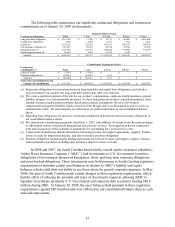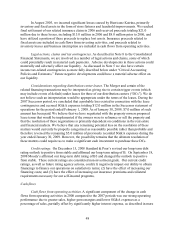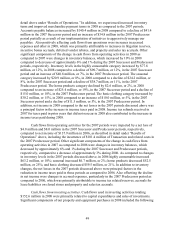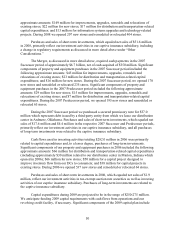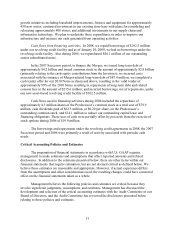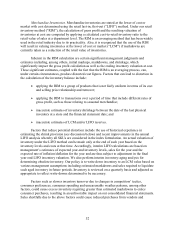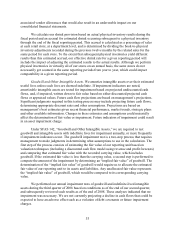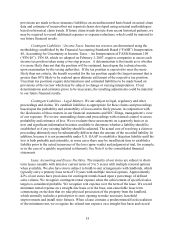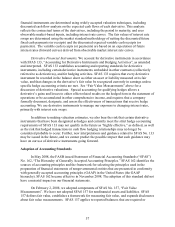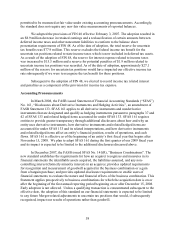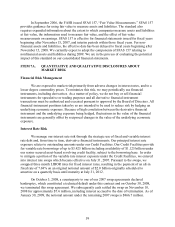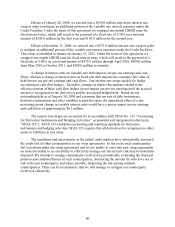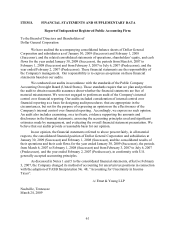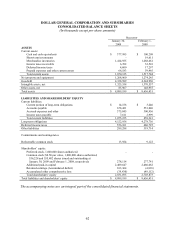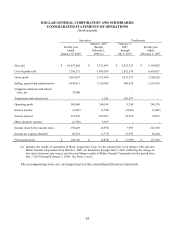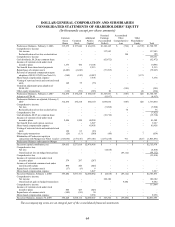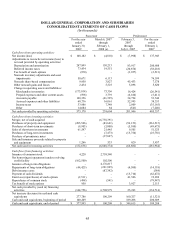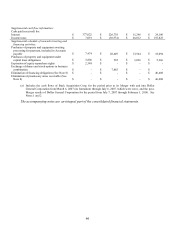Dollar General 2008 Annual Report Download - page 59
Download and view the complete annual report
Please find page 59 of the 2008 Dollar General annual report below. You can navigate through the pages in the report by either clicking on the pages listed below, or by using the keyword search tool below to find specific information within the annual report.57
financial instruments are determined using widely accepted valuation techniques, including
discounted cash flow analysis on the expected cash flows of each derivative. This analysis
reflects the contractual terms of the derivatives, including the period to maturity, and uses
observable market-based inputs, including interest rate curves. The fair values of interest rate
swaps are determined using the market standard methodology of netting the discounted future
fixed cash payments (or receipts) and the discounted expected variable cash receipts (or
payments). The variable cash receipts (or payments) are based on an expectation of future
interest rates (forward curves) derived from observable market interest rate curves.
Derivative Financial Instruments. We account for derivative instruments in accordance
with SFAS 133, “Accounting for Derivative Instruments and Hedging Activities”, as amended
and interpreted. SFAS 133 establishes accounting and reporting standards for derivative
instruments, including certain derivative instruments embedded in other contracts (collectively
referred to as derivatives), and for hedging activities. SFAS 133 requires that every derivative
instrument be recorded in the balance sheet as either an asset or liability measured at its fair
value, and that changes in the derivative’ s fair value be recognized currently in earnings unless
specific hedge accounting criteria are met. See “Fair Value Measurements” above for a
discussion of derivative valuations. Special accounting for qualifying hedges allows a
derivative’ s gains and losses to either offset related results on the hedged item in the statement of
operations or be accumulated in other comprehensive income, and requires that a company
formally document, designate, and assess the effectiveness of transactions that receive hedge
accounting. We use derivative instruments to manage our exposure to changing interest rates,
primarily with interest rate swaps.
In addition to making valuation estimates, we also bear the risk that certain derivative
instruments that have been designated as hedges and currently meet the strict hedge accounting
requirements of SFAS 133 may not qualify in the future as “highly effective,” as defined, as well
as the risk that hedged transactions in cash flow hedging relationships may no longer be
considered probable to occur. Further, new interpretations and guidance related to SFAS No. 133
may be issued in the future, and we cannot predict the possible impact that such guidance may
have on our use of derivative instruments going forward.
Adoption of Accounting Standards
In May 2008, the FASB issued Statement of Financial Accounting Standards (“SFAS”)
No. 162, “The Hierarchy of Generally Accepted Accounting Principles.” SFAS 162 identifies the
sources of accounting principles and the framework for selecting the principles used in the
preparation of financial statements of nongovernmental entities that are presented in conformity
with generally accepted accounting principles (GAAP) in the United States (the GAAP
hierarchy). SFAS 162 became effective in November 2008. The adoption of this standard did not
have a material impact on our financial statements.
On February 2, 2008, we adopted components of SFAS No. 157, “Fair Value
Measurements”. We have not adopted SFAS 157 for nonfinancial assets and liabilities. SFAS
157 defines fair value, establishes a framework for measuring fair value, and expands disclosures
about fair value measurements. SFAS 157 applies to reported balances that are required or


